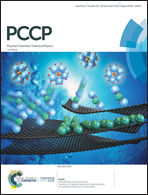Unraveling the regioselectivity of odd electron halogen bond formation using electrophilicity index and chemical hardness parameters†
Abstract
Odd electron halogen bonding of freons with five different free radicals have been investigated using M06-2X/6-311G++(d,p). Conceptual density functional theory parameters such as Fukui functions, electrophilicity index and chemical hardness have been utilised to examine the regioselectivity and strength of free radical induced halogen bonding. The strong electrophilic radical Cl˙ forms three-electron bonds upon interacting with the nucleophilic ring surrounding the sigma hole or fk− regions. This behavior is also observed for moderately electrophilic radicals OH˙ and OCl˙ for complexation with CHFCl2 only. In other complexes, these radicals along with least nucleophilic radicals ˙NO and ˙Ph form one-electron bond with sigma hole or fk+ regions of freons. This regioselectivity of radicals and the interaction energy upon complexation have been explained in terms of local electrophilicity index and chemical hardness. We hope that this finding will shed light on the understanding of non-covalent interactions in terms of conceptual density functional theory for halogen bonding as well as in pnictogen, chalcogen and tetrel bonding systems. This result may find applications in understanding the radical mediated reactions and ozone depletion in the stratosphere.



 Please wait while we load your content...
Please wait while we load your content...